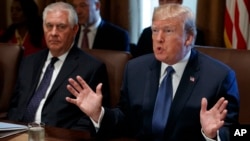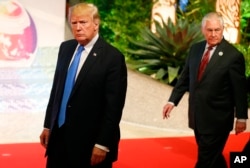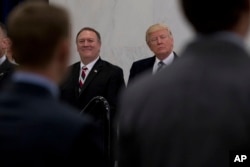Just minutes after Donald Trump fired Rex Tillerson on Tuesday, the president was blunt about his long-standing differences with his former secretary of state.
“We disagreed on things,” Trump told reporters outside the White House, specifically pointing to friction over the Iran nuclear agreement.
“I wanted to either break it or do something, and he felt a little bit differently,” Trump said. “We were really not thinking the same.”
Trump reportedly had considered firing Tillerson for months. But the decision - and the abrupt way it was executed - represents a dramatic end to a strained relationship.
Tillerson learned of his firing by an early-morning Trump tweet, according to Steve Goldstein, undersecretary of state. White House officials disputed that notion, and promptly fired Goldstein.
The move left some of Trump's staunchest defenders with mixed feelings.
“It’s all very Trumpian,” said James Carafano of the conservative Heritage Foundation, who helped staff the State Department as a member of Trump’s transition team. “When the president makes changes, he just abruptly makes them.”
Frictions on frequent display
During his 14 months at the State Department, Tillerson had numerous policy differences with Trump - and the friction frequently played out in public.
The animosity peaked in October, when news surfaced that Tillerson reportedly called Trump a “moron” following a July Pentagon meeting. Tillerson never explicitly denied the account.
Tillerson also publicly disagreed with Trump’s decision to pull out of the Paris climate accord. He reportedly opposed Trump’s decision to move the U.S. embassy from Tel Aviv to Jerusalem.
And Tillerson sometimes took a tougher stance than Trump on Russia — including this week, when he blamed Moscow for a suspected nerve agent attack in Britain.
In return, Trump on numerous occasions publicly undermined his top diplomat, including in October when he tweeted Tillerson was “wasting his time” trying to negotiate with North Korean leader Kim Jong Un.
When Trump ultimately made his decision last week to meet with Kim, he did so without consulting Tillerson.
“I really didn’t discuss it very much with him honestly,” Trump acknowledged Tuesday. “I made that decision by myself.”
The Tillerson firing comes as Trump embarks on several major foreign policy initiatives, including talks with Kim Jong Un, recently unveiled tariffs on imports of steel and aluminum, and Trump’s threats to undo the Iran nuclear deal.
As Trump becomes more confident in his foreign policy, he has come to realize that the U.S. diplomatic apparatus was holding him back in some ways, Carafano said.
“There’s always this kind of pull from the State Department to not try new things and just keep doing what we’re doing,” Carafano said. “And I think the president doesn’t feel that’s helpful anymore.”
The moves suggest the Trump administration “is tactically going to be a little bolder on its foreign policy,” he said.
New start with Pompeo?
It’s unclear whether Trump’s relationship with the State Department will improve under CIA chief Mike Pompeo, who Trump has selected to succeed Tillerson.
“I’ve worked with Mike Pompeo now for quite some time,” Trump said Tuesday. “Tremendous energy. Tremendous intellect. We’re always on the same wavelength.”
But the problem is deeper, said David Schultz, professor of political science at Minnesota’s Hamline University.
Trump does “not seem to view diplomacy as a major aspect of his administration,” Schultz said. “Evidence of that is that many State Department positions are unfilled even to this day, and many careerists have departed.”












